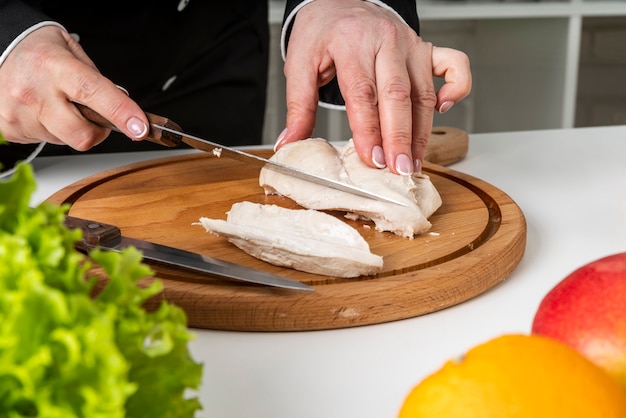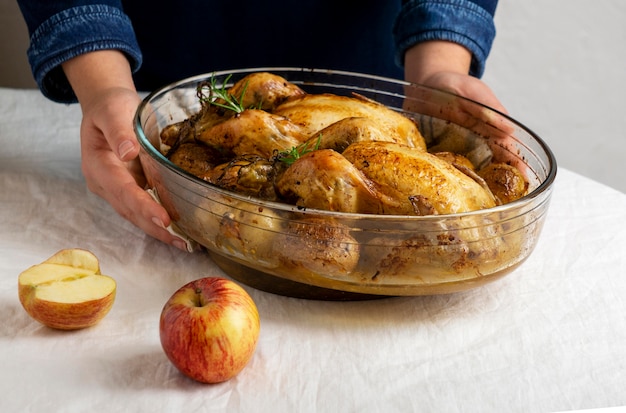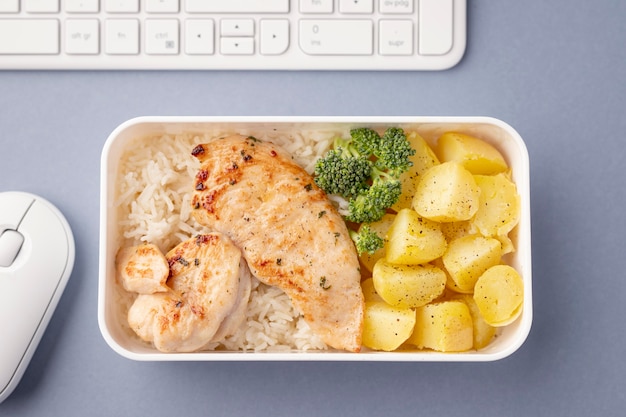Chicken parmesan, oh chicken parmesan! This Italian-American classic holds a special place in my heart, and it's a dish I've been perfecting for years. It's a symphony of flavors and textures, with crispy, golden-brown breading, juicy chicken, tangy marinara sauce, and gooey melted cheese. But the secret to achieving that perfect bite lies in the baking process.
Over the years, I've learned that baking chicken parmesan isn't just about sticking it in the oven and hoping for the best. It's about understanding the nuances of baking time, temperature, and technique. You want to ensure the chicken is cooked through, the cheese is melted and bubbly, and the breading is nice and crispy, without any hint of dryness or sogginess.
Join me on this culinary journey as we delve into the intricacies of baking chicken parmesan to perfection. We'll explore the science behind baking, uncover the secrets of achieving the perfect crust, and learn how to navigate those crucial moments of oven monitoring. Get ready to elevate your chicken parmesan game to new heights!
Part 1: The Science Behind the Bake

1.1 The Oven: Your Culinary Crucible
First, let's talk about the oven, the heart of this culinary adventure. It's our magical machine that transforms raw chicken into a golden, delicious masterpiece. And the key to mastering the oven lies in understanding its temperature.
1.2 The Power of Temperature
I've discovered that the ideal oven temperature for baking chicken parmesan is around 375°F (190°C). This temperature is hot enough to create that beautiful, golden-brown crust while ensuring the chicken cooks evenly without drying out.
1.3 Factors Affecting Baking Time: A Balancing Act
Now, the baking time isn't a set-in-stone formula. It's a delicate dance influenced by several factors:
- Chicken Thickness: Those thick, juicy chicken breasts need a little more time in the oven to cook through. Thinner breasts will bake faster.
- Chicken Size: Smaller pieces of chicken, like cutlets, will cook more quickly than larger breasts.
- Sauce Coverage: The amount of sauce you use can affect baking time. More sauce means more moisture, requiring a slightly longer bake.
- Cheese Selection: Some cheeses melt faster than others, influencing the overall baking time. For example, mozzarella melts quickly, while provolone might take a bit longer.
- Oven Variations: Every oven has its own personality. Some run hotter, while others run cooler. Pay attention to your oven's quirks to adjust baking times accordingly.
1.4 The Oven Thermometer: Your Culinary Guide
To navigate this complex world of baking variables, I always recommend using an oven thermometer. It's a simple tool that provides peace of mind, ensuring your oven is heating accurately and preventing those dreaded overcooked or undercooked disasters.
Part 2: Laying the Foundation for Success

2.1 Preheating: The Essential First Step
Before we even think about placing our chicken in the oven, we need to give it a proper warm-up. Preheating is a crucial step that ensures the oven is at the right temperature for a perfect bake. Set your oven to 375°F (190°C) and let it preheat for at least 15 minutes before you start baking.
2.2 Placement is Key: The Middle Rack Strategy
Once the oven is preheated and ready to go, think about where to position your chicken parmesan. The middle rack is my go-to spot for achieving even cooking. It allows heat to circulate evenly around the dish, ensuring a beautifully browned crust and perfectly cooked chicken.
2.3 Monitoring the Bake: A Culinary Vigil
It's tempting to just pop the chicken parmesan in the oven and forget about it, but resist that urge! I recommend checking the progress after about 20 minutes. This is your chance to observe how the breading is browning and the cheese is melting. If the edges are starting to brown but the center isn't cooked through, give it another 5 minutes or so.
Part 3: Mastering the Art of Breading

3.1 The Classic Breading Technique: Simple Yet Effective
The breading technique is fundamental to creating that signature crispy crust that elevates chicken parmesan to new heights. I've always found the traditional breading method to be a reliable winner. Dip the chicken breasts in beaten eggs, then coat them thoroughly in seasoned breadcrumbs.
3.2 Air Fryer: A Modern Twist on Breading
For those who crave that crispy texture but prefer a simpler approach, the air fryer is a fantastic option. This method produces a similar crunch without the oven preheating and long baking time. Just remember to use a baking sheet lined with parchment paper for easy cleanup.
3.3 Broiler Baking: For Maximum Crisp
If you're aiming for a super-crispy crust, consider using the broiler. This high-heat method delivers a beautifully golden brown finish, but be careful not to overcook. The broiler can quickly burn the breading, so keep a close eye on things.
Part 4: Decoding the Baking Time
4.1 Approximate Baking Times: A Starting Point
Here's a general guide for baking times, but remember, these are just estimates. It's essential to check the internal temperature of the chicken with a meat thermometer to ensure it's fully cooked.
| Chicken Thickness (Inches) | Approximate Baking Time (Minutes) |
|---|---|
| 1/2 inch | 20-25 |
| 3/4 inch | 25-30 |
| 1 inch | 30-35 |
4.2 Visual Cues for Doneness: A Culinary Guide
Besides using a meat thermometer, here are some visual clues that indicate your chicken parmesan is ready:
- The chicken is no longer pink in the center, indicating it's cooked through.
- The cheese is melted, bubbly, and slightly browned, signaling that it's ready to go.
- The breading is golden brown and crispy, achieving that perfect crunch.
4.3 Resting Time: A Crucial Step for Flavor
Once your chicken parmesan is out of the oven, don't rush to dig in. Allow it to rest for at least 5 minutes before serving. This allows the juices to redistribute, resulting in a more tender and flavorful chicken.
Part 5: Recipe Variations: Expanding Your Culinary Horizons
5.1 The Classic Chicken Parmesan: A Timeless Favorite
The classic chicken parmesan is a timeless recipe that never disappoints. It features breaded chicken breasts, topped with a flavorful marinara sauce and a generous layer of melted mozzarella cheese. It's a dish that brings back memories of family dinners and cozy evenings.
5.2 The Herb-Crusted Chicken Parmesan: A Flavorful Twist
For those who enjoy adding a touch of fresh flavor to their culinary creations, the herb-crusted chicken parmesan is a delicious option. It incorporates a blend of herbs, such as oregano, basil, and parsley, into the breading, creating an aromatic and flavorful experience.
5.3 The Spicy Chicken Parmesan: A Kick of Heat
If you're a fan of a little heat, the spicy chicken parmesan is the perfect choice. It uses a spicy marinara sauce and a sprinkle of chili flakes for an extra kick.
Part 6: Serving Suggestions: Completing the Culinary Experience
6.1 The Classic Pasta Pairing: A Timeless Combination
No chicken parmesan experience is complete without a side of pasta. I love serving it with spaghetti or fettuccine, tossed in a simple tomato sauce. It's a classic pairing that highlights the flavors of the chicken parmesan.
6.2 A Refreshing Side Salad: Balancing the Flavors
To balance the rich flavors of the chicken parmesan, I always recommend a refreshing side salad. A simple green salad with a light vinaigrette is a perfect complement.
6.3 Garlic Bread: Adding a Touch of Luxury
No Italian feast is complete without garlic bread. I always bake a fresh loaf of bread and brush it with garlic butter for a delicious and aromatic addition.
Part 7: Troubleshooting and Tips: Navigating the Culinary Challenges
7.1 Overcooked Chicken: Preventing Dryness
If you end up with dry chicken, you've likely overcooked it. The key to avoiding dryness is to monitor the internal temperature and avoid overbaking.
7.2 Soggy Breading: Achieving that Perfect Crunch
Soggy breading is often a sign that the chicken wasn't fully cooked before being coated. Ensure the chicken is completely dry before breading and bake it in a preheated oven for the recommended time.
7.3 Unevenly Cooked Chicken: Ensuring Even Browning
To ensure even browning and cooking, make sure the chicken breasts are a uniform thickness. Rotating the baking sheet halfway through the baking time will also help ensure even cooking.
Part 8: FAQs: Addressing the Common Questions
8.1 Can I Freeze Chicken Parmesan?
Yes, you can freeze cooked chicken parmesan for up to 3 months. To freeze, let it cool completely, then wrap it tightly in plastic wrap and aluminum foil. When ready to eat, reheat it in the oven at 350°F (175°C) for 20-25 minutes, or until heated through.
8.2 What is the Best Cheese for Chicken Parmesan?
While mozzarella is the most common choice, you can experiment with other cheeses like provolone, fontina, or even a blend of cheeses. Choose a cheese that melts well and adds a delicious flavor to the dish.
8.3 Can I Make Chicken Parmesan in Advance?
Yes, you can prepare the chicken parmesan in advance and bake it just before serving. Coat the chicken breasts, top them with sauce and cheese, and refrigerate them until ready to bake. This is a great way to save time and effort.
8.4 What Happens If the Chicken is Undercooked?
undercooked chicken can be a health risk. Always check the internal temperature of the chicken with a meat thermometer to ensure it has reached a safe internal temperature of 165°F (74°C).
8.5 What is the Best Way to Reheat Chicken Parmesan?
For the best results, reheat chicken parmesan in the oven at 350°F (175°C) for about 15-20 minutes, or until heated through. You can also reheat it in a skillet over medium heat with a little bit of olive oil, or in the microwave for a quicker option.
Now you're armed with the knowledge and techniques to create the most delicious baked chicken parmesan. Remember, it's all about finding the right balance of baking time, temperature, and technique. So get creative, experiment, and enjoy the journey to chicken parmesan perfection!
Everyone is watching

Corn on the Cob: The Ultimate Guide to Perfectly Cooked Ears
Healthy MealsAh, corn on the cob. Just the name evokes images of sunny days, barbecues, and that sweet, juicy flavour that ...

Perfect Pork Roast Oven Cooking Time: A Guide to Delicious Results
Healthy MealsThere's something truly satisfying about a perfectly roasted pork. The aroma alone is enough to make your mout...

Ham Cooking Time: How Long to Bake, Smoke, or Boil a Delicious Ham
Healthy MealsAh, ham. It's a classic, isn't it? A real crowd-pleaser, especially around holidays. And when done right, it'...

Scallops: The Ultimate Guide to Perfect Cooking
Healthy MealsAh, scallops. Those delicate, sweet, and utterly delicious morsels of the sea. They hold a special place in my...

Spaghetti Squash: The Ultimate Guide to Cooking and Serving
Healthy MealsRemember that time you saw spaghetti squash at the supermarket, looking all bumpy and strange, and thought, "W...
